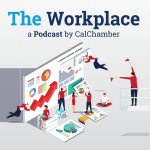In Episode 69 of The Workplace podcast, CalChamber Executive Vice President and General Counsel Erika Frank, and employment law expert Jennifer Shaw offer tips and insights on how employers can prepare to bring teleworkers back into the office once COVID-19 stay-at-home orders are lifted.
Set Expectations for Returning to Work
Some employees who are working remotely due to the COVID-19 pandemic may assume that since they have been performing their duties from home to the satisfaction of their employer, they may continue to work from home once the office reopens and may ask if they can continue to telework, Frank says.
Employers are not legally required to allow employees to telework unless there is an accommodation issue, Shaw explains. And even if there is an accommodation request, some essential job duties cannot be performed from home, and thus the request may sometimes be denied.
The COVID-19 crisis, however, has complicated the “essential job duties” reasoning since workers who have not traditionally been afforded the ability to work from home are now doing so. Due to this, Shaw recommends that employers think ahead and avoid making comments such as, “It’s amazing how you can do every part of your job from your living room!”
In doing so, the employer is supporting the idea that all functions of the job can be performed satisfactorily from home.
Shaw says employers can point out that while an employee is now working from home, it does not mean that the worker is performing their essential duties. At Shaw’s law firm, for example, the firm receptionist is working from home but is no longer answering phone calls—a duty that is typically an essential function of the position once the office reopens.
Shaw also recommends establishing a COVID-19-specific remote work agreement. This sets up the expectation that once the office reopens, remote employees will have to return to the office to work.
Reopening the Office
Now is the time for employers to think about and plan for how they will reopen their office once stay-at-home orders are lifted, Shaw says.
Frank emphasizes that it’s particularly hard to plan because there are so many unknowns and so much piecemealing of laws throughout the state.
In California, orders will be lifted in phases and will be industry specific, Shaw says. Therefore, the way a business reopens will depend on the type of business it is.
In planning, Shaw recommends that employers think about how they will be able to ensure the safety of their workers by:
• Following recommendations from the U.S. Centers for Disease Control (CDC).
• Assessing protection supplies and establishing a cleaning protocol. Are there enough sanitation wipes and masks? How will the office be sanitized or how often will the office be deep cleaned?
• Determining whether outside visitors will be allowed to come into the office. If allowed, will visitors be required to wash their hands and wear masks?
• Reconsidering workstation layouts to ensure employees are spaced more than 6 feet apart.
• Finally, evaluating whether work shifts should be staggered or alternative workweeks (such as working 10-hour shifts, four days a week) should be adopted temporarily to minimize the number of employees present in the workplace at once. For example, Shaw says, can a manufacturing business that previously created Part A, Part B and assembled both parts into a product every day, spread out the work, creating Part A on Mondays, Part B on Tuesdays and assembling the product on Wednesdays?
As employers weigh their options, Frank reminds listeners that not all labor laws have been suspended due to the COVID-19 crisis, and therefore employers still must abide by employment laws governing meal and rest break periods, alternative workweek scheduling requirements, or, in the case of San Francisco, predictive scheduling requirements.
Subscribe to The Workplace
Subscribe to The Workplace on iTunes, Google Play, Stitcher, PodBean and Tune In.
To listen or subscribe, visit www.calchamber.com/theworkplace.


